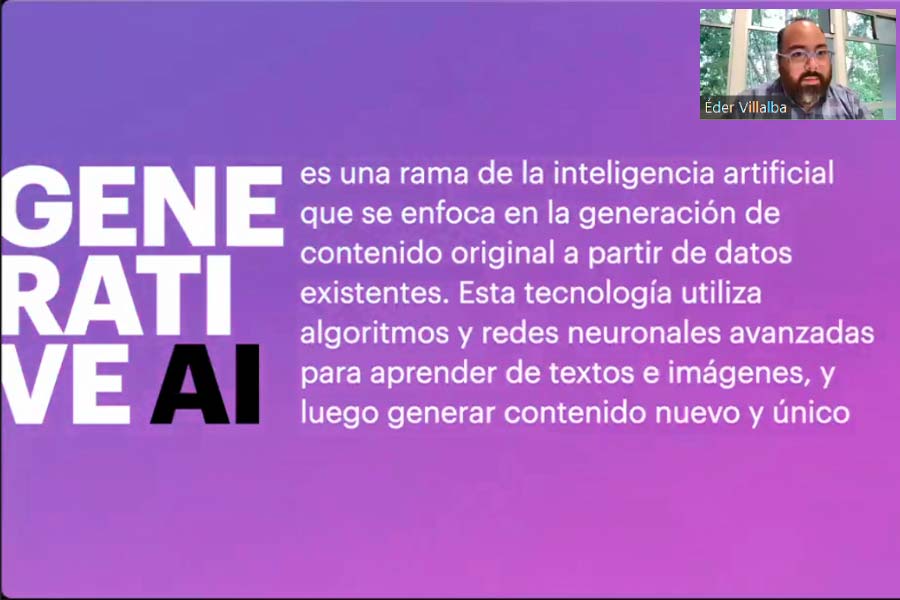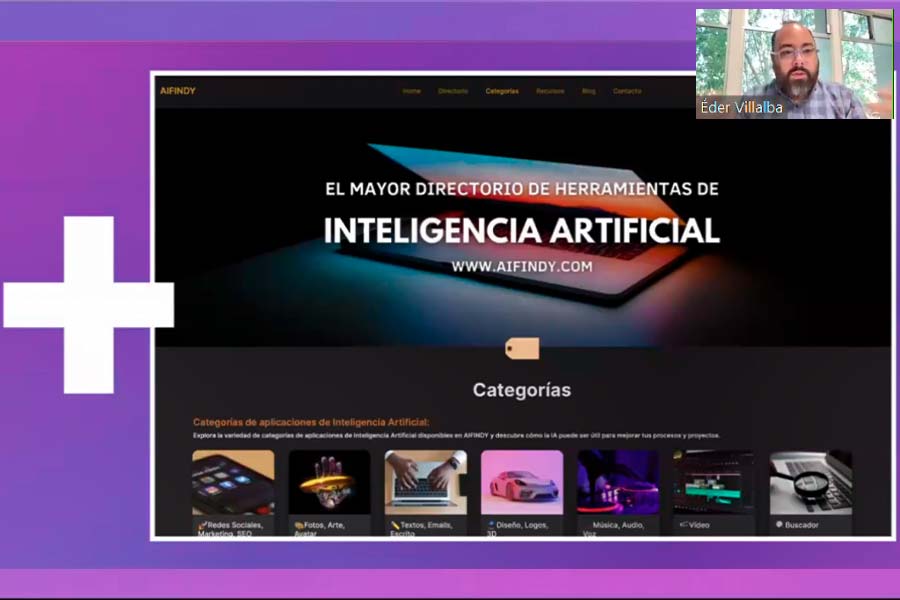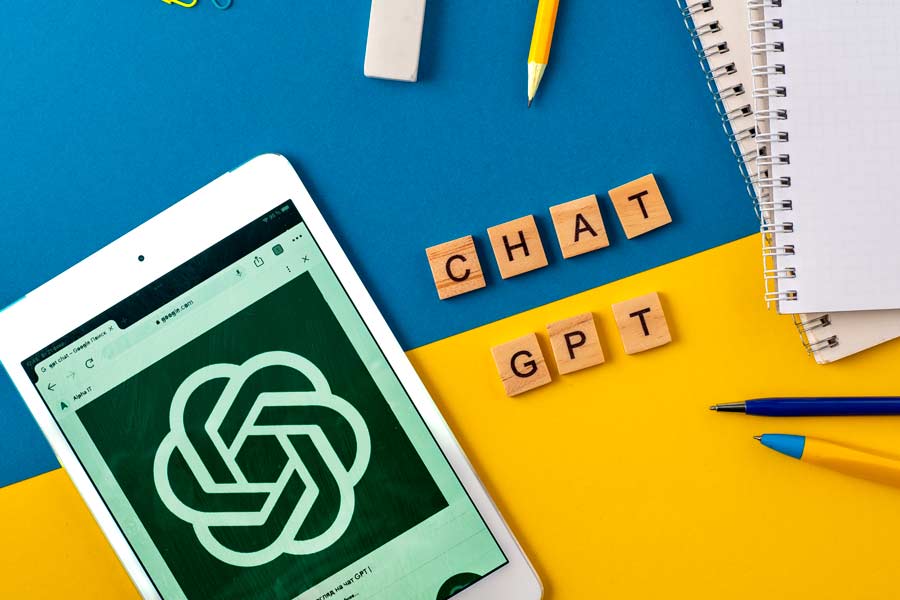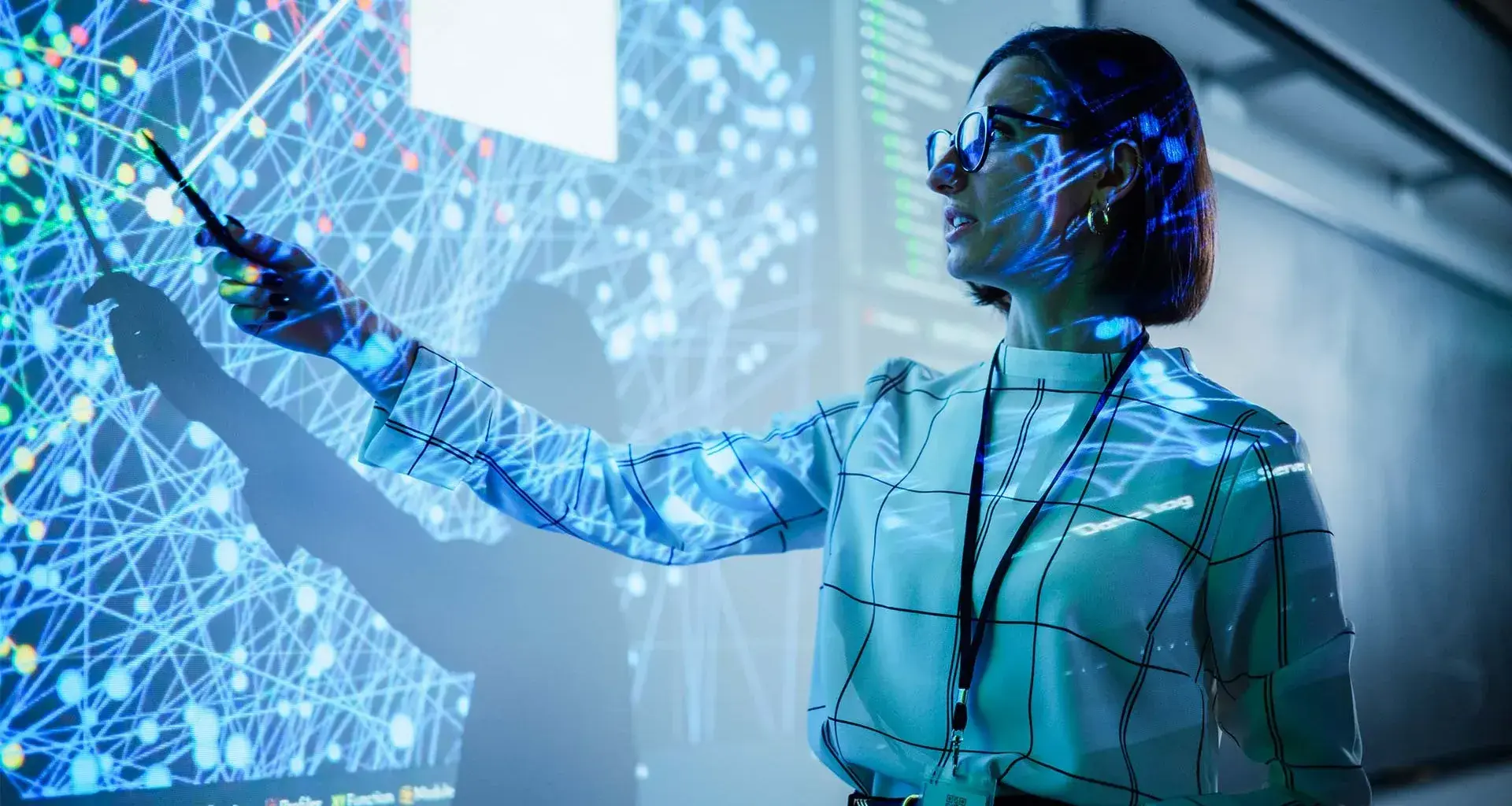How can university professors take advantage of Artificial Intelligence (AI) tools to create content that helps personalize learning? What other applications, besides ChatGPT, can be useful in the classroom?
Eder Villalba, Educational Innovation Leader for Tec de Monterrey’s Southern Region, pointed out that AI is a tool that can disrupt different areas of life, especially education.
“Very few things have disrupted education, one of the most recent being distance learning, which is why it’s important to visualize what changes are coming and how this technology might help us,” he said.
During his “Artificial Intelligence for Personalized Learning” talk, the expert pointed out that Generative AI allows teachers to create content to be incorporated into the classroom.
CONECTA provides you with recommendations on AI tools for personalized learning.

What is Generative Artificial Intelligence?
It’s becoming increasingly popular to use Generative Artificial Intelligence to create different types of content, such as images, text, videos, and even music, pointed out Villalba.
“We’re moving from information processing to content creation. Some of the tools that you can incorporate into the classroom are undoubtedly already being implemented by students in various things,” he said.
He explained that this branch of artificial intelligence is focused on generating original content from existing data. Through the use of algorithms and advanced neural networks, it is able to learn and then generate new and unique content.
“We’re moving from an information-seeking mindset to one of asking questions, and above all, in a natural way, as we would with any person. This is going to change how we receive, provide, and develop education,” he said.
The expert invited Tec professors to find new ways of benefitting from this type of tool, beginning with experimenting and starting to use different applications, beyond what ChatGPT already offers.
Villalba suggested searching an Artificial Intelligence Tools Directory such as AIFINDY, one of the most up-to-date AI application and software search engines, which divides the tools into categories that, in his opinion, could be useful to teachers.
“We need to think about how we can leverage artificial intelligence to offer personalized learning to students.”
The dream of personalized learning
For Villalba, one of education’s greatest dreams is to achieve personalized learning.
“It means that we want to tailor learning experiences to meet the unique needs and preferences of individual students,” he explained.
This approach, he added, recognizes that students have unique learning styles, interests, and abilities, and it seeks to facilitate a more student-centered education system.
Bearing this in mind, Villalba says that the “average student” doesn’t exist. It’s not something that can be measured like age because students’ characteristics are very diverse.
“We still live in a world in which education requires administrative efficiency in order to function. We need to have large groups, which goes against personalization because we design and propose resources by thinking about the average.”
According to the expert, it’s through technology that more and more possibilities are opening up to provide more personalized learning.
“We need to think about how we can leverage artificial intelligence to offer personalized learning to students,” he added.

3 components of personalized learning
Villalba invited teachers to reflect on what learning personalization options they offer their students in their classes.
“It isn’t just about building certain options, but also which ones we’re giving them in terms of empowerment, autonomy, and agency, so that they can decide, so that they can accomplish the learning experience they want or that is the most optimal for that person,” he said.
Likewise, the expert proposed 3 components of personalized learning:
- Engagement
This consists of being able to offer decision-making options and autonomy to students.
“So that they can choose and build their own curriculum together with the group or class and then choose the path on which to reach a goal or achieve a skill,” he said.
He pointed out that technology can help create study plans for students and they can receive mentoring, orientation, and validation from their teachers.
- Representation
This is the notion of providing visualization and information-processing alternatives.
“Co-designing together, through different dialogues that have to do with technology, and also being able to consider different ways of expressing things,” he said.
- Action and expression
Access to tools and assistive technology for building and creation.
“This is where it comes up against this type of technology known as generative artificial intelligence,” he added.
“We’re moving from an information-seeking mindset to one of asking questions, and above all, in a natural way as we would with any person.”
Examples of Generative AI in the classroom
The speaker shared some AI tools with professors so that they could reflect on how this could help them with their students’ learning process.
- ChatGPT
This enables consultations, explanations, reinterpretations, inquiry, co-ideation, and co-creation.
“Our students’ knowledge and thought construction could be carried out in a way that is natural to each individual. They can ask and acquire what they need in terms of this construction,” he said.
ChatGPT can also be a tool for creating personalized study plans or for creative processes, as well as finding the best way to learn from their current standpoint.
“It’s very simple to ask it to build us a learning path. You’ll get a résumé that you can put into practice, tips and best practices for achieving it, and it will generate many variables for you,” he added.
“I can say to ChatGPT, ‘I want you to ask me 20 things I need to know about learning styles, so that you can tell me which is the best option for my learning style.’ We can provide information from our profile, and it can offer us a more personalized route based on that,” he explained.
- Quizgecko
This is a question-and-answer generator for quizzes or trivia, which can be useful as a self-study app.
“As a teacher, I can use it to create quizzes or trivia in the classroom, to do something fun that’s related to learning but with a playful or practical factor.
“But it can also be used by my students in terms of increasing their understanding of that content,” he suggested.
- Midjourney
This tool generates graphic art, visual thinking, and conceptual artistic proposals. It can be used for creativity and content generation or for rapid prototyping.
“This can help us conceptualize things, such as abstract terms in learning. These abstractions are often not easy to internalize, but we can achieve this through images or art that make sense to students, such as the concept of human flourishing,” he said.
Villalba pointed out that very specific instructions can also be given when generating images by describing concepts.
“Through this content visualization, we can create personalized learning. We can say, ‘Hey, I want to take this branch or learn from this point of view or from this situation,’” he said.
- Fliki
This is a tool that can create text-to-video content. It offers agile personalized content development for educational materials and resources or for producing projects.
He also pointed out that it can be combined with other applications that can create text to audio, or speech to text, to enrich content that can help students have more personalized content.
Villalba said that these and other AI applications may be available for free, with a premium paid option, or also a paid version.

Artificial Intelligence for university professors
CONECTA has carried out the exercise of consulting ChatGPT on how generative artificial intelligence can be useful to university professors and help them in the teaching-learning process.
The application responded that this technology is not intended to replace teachers, but to complement their role and offer them additional tools for their work.
Some possible applications suggested by ChatGPT include:
- Assisting with material preparation to create teaching materials, such as presentations and other learning resources.
- Automatic feedback by analyzing responses and student work and offering suggestions for improvements.
- Data analysis and machine learning by identifying patterns and trends in student performance to better understand your students’ strengths and areas of opportunity.
- Personalized learning by collecting information about students’ interests and individual preferences in order to make recommendations on resources and activities adapted to each student.
- Research support by analyzing large amounts of scientific literature and summarizing or analyzing other research, as well as accelerating the literature review process.
In terms of how teachers can know which is the ideal AI tool or application for their course or unit, Villalba explained that a reconnaissance process will be necessary in order to incorporate this technology into the classroom.
“This has to do with didactic planning in terms of the strategies we’re looking for. From the very beginning, you have to look at what learning goal you have in mind and, from there, make distinctions about content and strategies, techniques, and tools.
“Since this is an emerging technology, assessment has to be much more agile, and for now it will involve a lot of trial and error. As early adopters, you are going to create as much feedback as possible for other people in the future to capitalize on and produce something positive in the classroom,” he concluded.
About the 2023 National Teachers’ Conference
The talk was held as part of Tecnológico de Monterrey’s 2023 National Teachers’ Conference.
Taking place as part of Tecnológico de Monterrey’s 80th anniversary, the tenth National Teachers’ Conference (RNP) was an opportunity for teachers to meet and continue learning, growing, and connecting.
Juan Pablo Murra, Rector for Higher Education at the Tec, invited professors to see the RNP as an opportunity to meet, connect, and collaborate to resume discussions with colleagues and make new connections.
“Marking our 80th anniversary was an important reason to meet up. Together, let’s continue building a great faculty, a great Tecnológico de Monterrey, and making progress on the impact we’re going to have,” said the director.
RNP 2023 took place over 3 days, from July 3 to 5, on the Monterrey campus.
ALSO READ:





